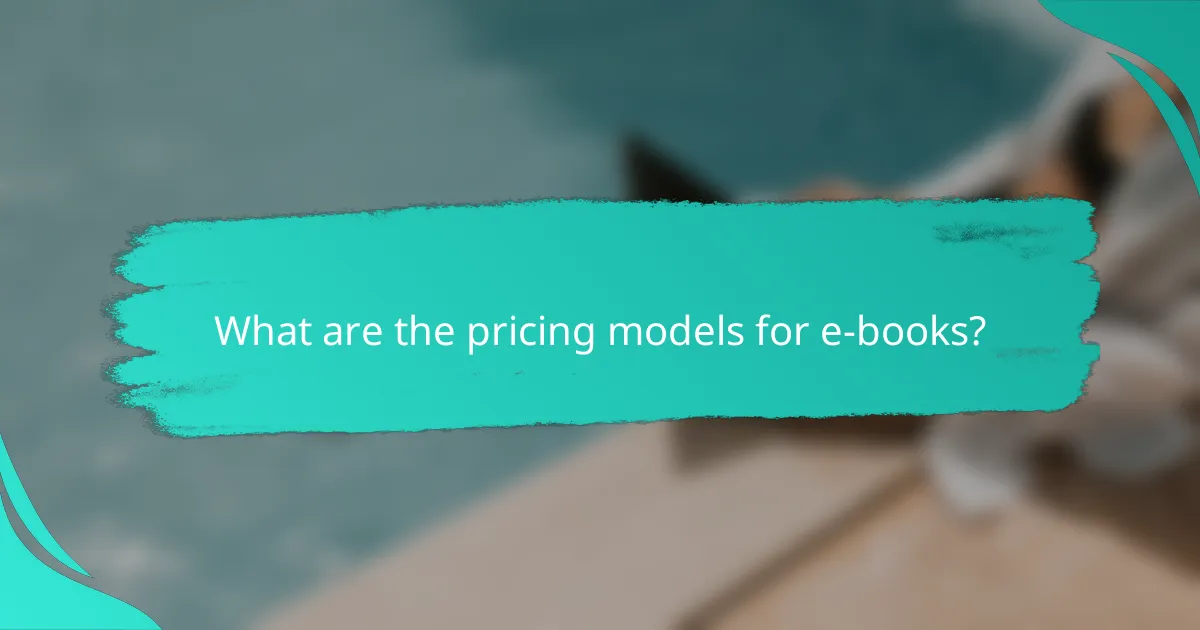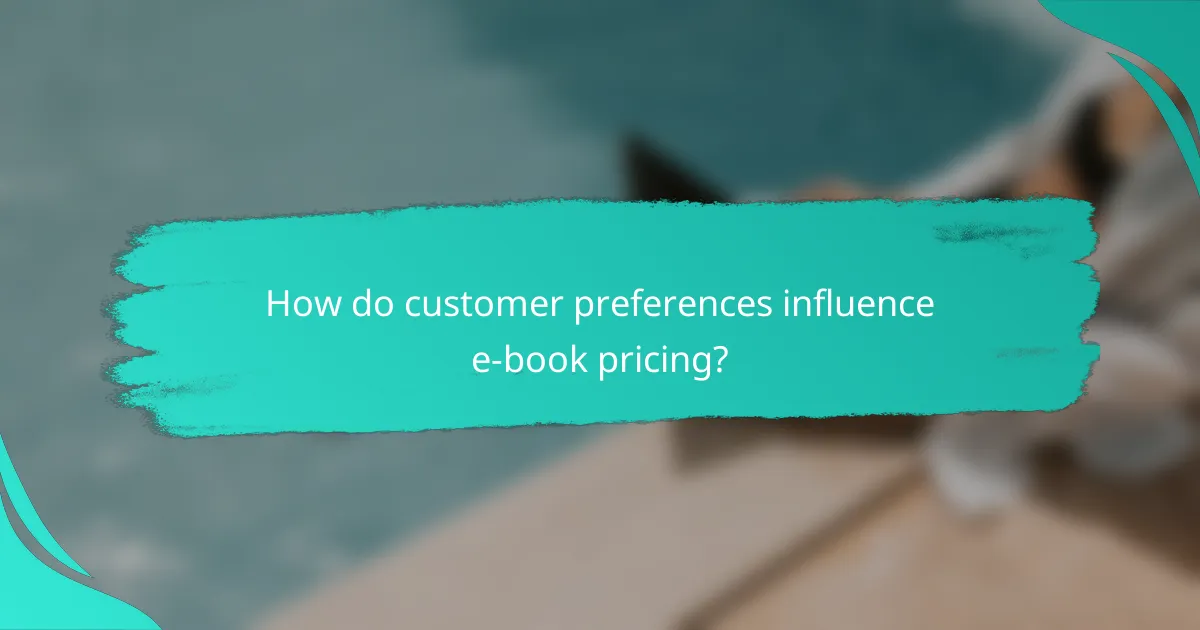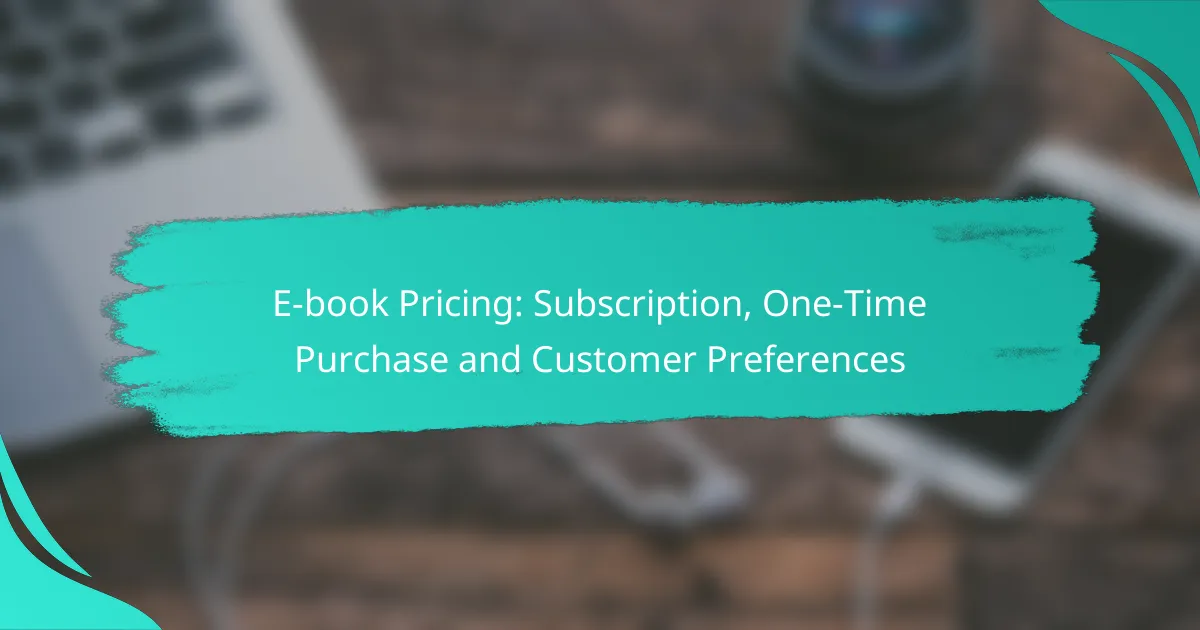E-book pricing models, including subscription and one-time purchase options, play a crucial role in how readers access digital content. Customer preferences significantly influence these pricing strategies, guiding publishers in setting competitive prices that meet consumer expectations. Subscription services, in particular, offer an appealing way for avid readers to explore a wide range of titles without the need for individual purchases.

What are the pricing models for e-books?
E-book pricing models primarily include subscription, one-time purchase, freemium, and pay-per-download options. Each model offers distinct advantages and considerations for both consumers and publishers, influencing how readers access and pay for digital content.
Subscription model
The subscription model allows readers to pay a recurring fee, typically monthly or annually, for access to a library of e-books. This model is popular among avid readers who prefer variety and frequent reading without the commitment of purchasing individual titles.
Services like Kindle Unlimited and Scribd exemplify this approach, offering thousands of titles for a flat fee. Readers should consider their reading habits and preferences, as this model can be cost-effective for those who read multiple books each month.
One-time purchase model
The one-time purchase model requires readers to buy each e-book individually, granting them permanent access to the title. This model is straightforward and appeals to readers who prefer owning their books rather than subscribing.
Prices for e-books in this model can vary widely, typically ranging from a few dollars for self-published works to higher amounts for new releases from popular authors. Readers should evaluate their interest in specific titles and consider potential discounts or promotions.
Freemium model
The freemium model offers basic content for free while charging for premium features or additional content. This approach can attract a wide audience, allowing readers to sample e-books before committing to a purchase.
For example, some platforms may provide the first chapter or a limited selection of titles for free, encouraging users to upgrade for full access. Readers should be aware of potential upselling tactics and assess whether the premium content justifies the cost.
Pay-per-download model
The pay-per-download model charges readers for each e-book they download, similar to the one-time purchase model but often used for specific platforms or services. This model can be advantageous for readers who prefer to buy only select titles rather than subscribing.
Prices typically align with the one-time purchase model, and readers should look for platforms that offer competitive pricing and a wide selection. It’s essential to compare options to ensure they are getting the best value for their chosen titles.

How do customer preferences influence e-book pricing?
Customer preferences significantly shape e-book pricing strategies, as they dictate whether readers lean towards subscription models or one-time purchases. Understanding these preferences helps publishers and retailers set competitive prices that align with consumer expectations.
Preference for subscription services
Many readers prefer subscription services because they offer access to a vast library of e-books for a fixed monthly fee. This model appeals to avid readers who enjoy exploring various genres without the burden of individual purchases.
Subscription services typically charge between $10 to $20 per month, allowing users to read multiple titles without significant financial commitment. However, the challenge for providers is to maintain a diverse and engaging selection to retain subscribers.
Desire for ownership with one-time purchases
Some customers favor one-time purchases as they want to own the e-books they buy, often valuing the permanence and control that comes with ownership. This preference is common among readers who have specific authors or series they follow closely.
Prices for one-time purchases usually range from $5 to $15 per e-book, depending on factors like popularity and format. While this model can yield higher upfront revenue for publishers, it may limit the overall reach compared to subscription services.
Impact of genre on pricing preferences
The genre of an e-book can significantly influence pricing preferences, as different genres attract varying levels of demand and reader willingness to pay. For instance, bestsellers in popular genres like romance or thriller may command higher prices than niche genres.
Readers of genres such as self-help or educational materials may be more inclined to invest in one-time purchases, while those interested in fiction might prefer subscriptions to explore a wider range of titles. Understanding these dynamics can help publishers tailor their pricing strategies effectively.

What are the advantages of subscription e-book services?
Subscription e-book services offer readers access to a vast library of titles for a fixed monthly fee, making them an attractive option for book lovers. These services often provide a cost-effective way to explore diverse genres and authors without the commitment of purchasing individual books.
Access to a wider library
One of the primary benefits of subscription e-book services is the extensive library they provide. Subscribers can access thousands of titles across various genres, including fiction, non-fiction, and academic works. This variety allows readers to discover new authors and explore different subjects without the risk of investing in books they may not enjoy.
Many platforms, such as Kindle Unlimited and Scribd, regularly update their catalogs, ensuring that subscribers have access to new releases and popular titles. This constant refresh keeps the reading experience dynamic and engaging.
Cost-effectiveness for avid readers
For avid readers, subscription e-book services can be significantly more economical than purchasing individual books. A monthly subscription fee often equates to the cost of just one or two new releases, allowing readers to consume multiple titles within that same period. This model is particularly appealing for those who read frequently and enjoy exploring various genres.
Additionally, some services offer family plans or discounts for longer subscription commitments, further enhancing the cost-effectiveness for households with multiple readers. This flexibility can lead to substantial savings over time.
Flexibility in reading choices
Subscription e-book services provide readers with the flexibility to choose what they want to read without the pressure of a financial commitment for each title. This freedom encourages exploration and experimentation with different authors and genres. Readers can easily switch between books, trying out new styles or topics that pique their interest.
Moreover, many platforms allow users to download books for offline reading, making it convenient to enjoy titles anywhere, whether commuting or traveling. This adaptability enhances the overall reading experience and caters to varying lifestyles.

What are the drawbacks of one-time e-book purchases?
One-time e-book purchases can lead to several drawbacks for consumers, primarily due to the upfront financial commitment and limited access to a wider range of titles. Readers may find themselves spending more initially and missing out on new releases or trial options that subscription services often provide.
Higher upfront costs
One-time e-book purchases typically require a higher initial investment compared to subscription models. For example, a single e-book may cost anywhere from $5 to $15 or more, depending on the title and publisher. This can add up quickly, especially for avid readers who want to explore multiple genres or authors.
In contrast, subscription services often charge a monthly fee, which can be more budget-friendly for frequent readers. For instance, a subscription might range from $10 to $20 per month, allowing access to a library of titles without the need for individual purchases.
Limited access to new releases
With one-time purchases, readers may face delays in accessing new releases. Publishers often prioritize their latest titles for subscription services, meaning that those who buy e-books outright might have to wait longer to read popular new books. This can be frustrating for fans eager to stay current with their favorite authors.
Additionally, some e-books may not be available for purchase immediately, as they might be exclusive to certain platforms or subscription services for a limited time. This exclusivity can restrict a reader’s options and lead to missing out on trending titles.
No trial options for readers
One-time e-book purchases do not typically offer trial options, making it difficult for readers to assess whether a book meets their expectations before committing financially. Unlike subscription services that often provide free trials or sample chapters, one-time purchases require full payment upfront.
This lack of trial options can lead to buyer’s remorse if the book does not resonate with the reader. To mitigate this risk, readers should consider checking reviews or reading excerpts before making a purchase to ensure the e-book aligns with their interests.

How do e-book pricing strategies vary by region?
E-book pricing strategies differ significantly across regions due to factors like market maturity, consumer preferences, and local regulations. Understanding these variations can help publishers and authors tailor their pricing models effectively.
Pricing differences in North America
In North America, e-book prices typically range from $5 to $15, depending on the genre and author popularity. Bestsellers often command higher prices, while independent authors may price their works lower to attract readers.
Subscription services like Kindle Unlimited have gained traction, allowing readers to access a wide range of titles for a monthly fee, usually around $10. This model influences pricing strategies, as authors may choose to lower their prices to increase visibility within these platforms.
European e-book pricing trends
European e-book pricing varies by country, with prices generally falling between €3 and €12. In countries like Germany and France, e-books are often priced higher due to VAT regulations that can reach 20% or more.
Subscription services are also popular in Europe, with platforms like Scribd and BookBeat offering access to numerous titles for a monthly fee. This trend encourages authors to consider competitive pricing to attract subscribers.
Emerging markets and pricing strategies
In emerging markets, e-book pricing strategies are often influenced by local purchasing power. Prices can range from $1 to $5, making e-books more accessible to a broader audience. Authors and publishers may adopt lower pricing to penetrate these markets effectively.
Additionally, mobile reading apps are popular in these regions, and pricing strategies may include promotional offers or bundling with other digital content to enhance value. Understanding local consumer behavior is crucial for successful pricing in these markets.

What factors should be considered when choosing an e-book pricing model?
Choosing an e-book pricing model involves evaluating various factors such as target audience, market trends, and revenue goals. Understanding these elements can help in selecting a model that maximizes sales and meets customer expectations.
Target audience demographics
Identifying the demographics of your target audience is crucial when selecting an e-book pricing model. Factors such as age, income level, and reading habits can influence whether customers prefer subscription services or one-time purchases.
Younger audiences may lean towards subscription models, valuing access to a wide range of titles for a monthly fee, while older readers might prefer the simplicity of one-time purchases. Conducting surveys or analyzing sales data can provide insights into your audience’s preferences.
Additionally, consider regional differences in purchasing power and reading culture. For instance, in Europe, e-book prices may need to be adjusted to reflect local currencies like EUR or BGN, ensuring affordability and competitiveness in the market.
